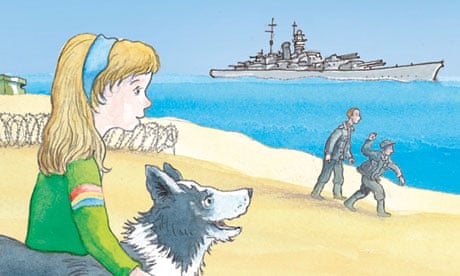I was in a car with Michael Morpurgo, his wife Clare and a couple of publishing people. We were driving through Suffolk to launch a new book, Not Bad for a Bad Lad, which is set partly in a prison at Hollesley Bay. Bits of the early narrative are based on some recollections of my Suffolk schooldays. (Miss West, the music teacher, who said I sounded like a frog and turned me into a drummer.)
I was boring my fellow passengers with a few more of my childhood memories and happened to mention the period at the end of the second world war when Italian prisoners of war were sent to our village to help on the farms and clear mines and barbed wire from the beach. It was extraordinary, really, because most of the men of the village, Pakefield, were still overseas and the "enemy" were working in and around our village. The Italians loved football, we boys loved football, so we all played football together.
In the neighbouring village, Kessingland, there were German prisoners clearing the beaches of mines and the detritus of war. My cousin, Gwen, married one of them and this in a village where the little school had been bombed. The war really was over!
"That's the one," said the other Michael. "That should be our next book."
He had already been approached by HarperCollins to write a book to be published in partnership with the Imperial War Museum. We went to a meeting at the museum, having already mentioned our subject would be prisoners of war in this country. On the table in front of us the curators had placed a marvellous dog. A wooden dog with red wheels. The dog's body was articulated so it wiggled and waggled when pulled along by a bit of string. It had been made, they said, by a German prisoner of war for a little girl on the farm where he and other prisoners of war worked. The museum folk said they would like the book to be about something in the museum's collection.
The other Michael gave me one of his "looks". Cousin Gwen wasn't mentioned. We would save her for another day. The star of our book would be the little dog.
Michael liked the name Kessingland. He thought it had a German sound to it, so we had the location and some characters. I described the layout of Kessingland – one street leading from the London Road (A12) past the Church to the beach. I talked of the farm above the marshes where I used to stack stooks of wheat and barley during harvest time and the cliffs between Pakefield and Kessingland where we boys would walk after finishing our Sunday morning paper rounds, a bottle of pop at The Sailors' Home and a penny bus ride back.
The great spin Michael put on the story was the date of the characters' reunion at the end – 1966. Yes, England's victorious World Cup year! What Michael didn't know was that I had been to every game and still had all the tickets. Not only that but, Paul, the mate I went to all the World Cup games with, a Londoner, now lives on the cliff top at Kessingland! It is Paul's house you see in my drawings of the beach.
Fact, coincidence, imagination, friendship. Classic Morpurgo ingredients stirred by a master storyteller.
